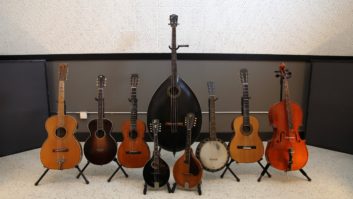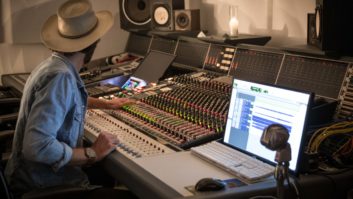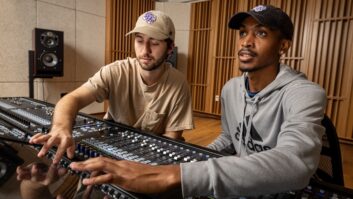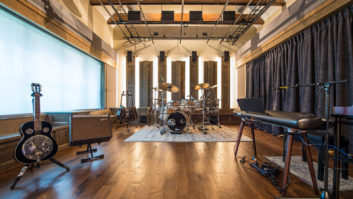BEXLEY, OH—With the construction of its first academic building in a half-century, Capital University of Bexley, Ohio has gained the Convergent Music Center (CMC), which will host multi-disciplinary curriculum and real-world experiential learning courses for programs including Music Technology, Radio, Digital Media, Communication and Business. The CMC effectively adds 50 percent more production space to the Music Technology program’s space, currently housed at the University’s Conservatory of Music.
“The CMC has been a project over two years in the making,” explains Capital University assistant professor Chad Loughrige. “The Music Technology program has seen tremendous growth since its inception in 2004. In my 10 years at Capital, I’ve seen it grow from 45 students to over 150. The ‘Electronic, Media, and Film’ program has also seen similar growth in recent years. The administration of the university saw this as an amazing opportunity to bring multiple media-rich programs together into a single building and provide new curriculum, facilities and collaborations unique to Capital University. The vision of the building is to provide new and extended resources to students…and also provide future opportunities for these programs to collaborate with other programs. Business, English, Public Relations and Communication departments have a unique opportunity to build curriculum that connect all these areas together; an ‘agency’ of sorts is being created in the CMC. Students from multiple programs will have access to all stages of production, and will build an understanding of how each area can aid in project completion.”
As part of the CMC’s holistic setup for media production and commerce training, non-audio technologies (such as video and graphic design) are thoughtfully included in the media center. “Currently, [our] Music Technology programs have oversight by the University’s Conservatory of Music,” explains Loughrige. “The School of Communication oversees the media, broadcast and graphic design programs. Students from all programs often intermingle in courses and extracurricular activities because of the strong ‘minor degree’ options available at Capital. For example, our ‘Bachelor of Arts in Professional Studies: Music Technology’ degree strongly suggests a minor in an outside field. Many of the students in this program choose the Digital Media minor. That minor includes courses such as Media Writing, Video Production, Commercial Design and Digital Computer Imaging. Students who choose this path are building a wide set of professional skills that will aid them in multiple career opportunities.”
https://www.youtube.com/watch?v=DihRDHQmG7Y
The goal of producing wellrounded graduates comes via insight from alumni who share their experiences with the faculty after a few years in the field. “We’ve been in communication with our graduates to research program effectiveness, job preparedness, and career sustainability,” offers Loughrige. “We’ve found that our graduates require an understanding of multiple technical and skill-based areas. Students are finding jobs where audio production, video editing, composition, lighting and business marketing are all required in their day-today responsibilities. Lower budgets and entrepreneurial starts-ups often have employers looking for individuals with skills in all these areas, as they are not able to hire multiple people for all these positions.”
The CMC includes a 1,400-square-foot recording studio, four mixing and post-production suites, an 18-station computer lab and a teaching/performance space for live sound training. The building also includes graphics design and video production labs, a new television studio, radio station, and several media-rich classrooms. Designed for multiple uses, the main studio is built around a 5.1 surround monitoring system with multiple integrated displays and features an API The Box-anchored modular recording system with plentiful outboard analog processing from multiple manufacturers including API, Chandler, Daking, Empirical Labs, Focusrite, Great River, Manley Labs, Purple Audio, Radial Engineering, Rupert Neve Designs, Shadow Hills, Solid State Logic, Universal Audio and Vintech, among others. These external preamps, compressors and EQs act as the analog front end to a Pro Tools HD rig, controlled via four Avid ArtistMix suites. The suites, finely finished with Primacoustic acoustic panels and various other Primacoustic components, serve as professional-grade workspaces for students while they complete classwork and various projects.
“The main studio had to be multifunctional,” offers Loughrige on the scope of the CMC project. “It had to be large enough to be a ‘classroom’ for our students, fitting 15-20 students comfortably. It had to meet the needs of our current curriculum, which include traditional tracking projects, mixing, voiceovers and post-production. Meeting all these needs is what eventually led us to a modular design for the desk and components.”
Radial Engineering-racked 500 Series processors give Capital students opportunities to hear what analog tone imparts upon their productions.

Choosing API’s The Box and a slew of outboard was a decision made for a variety of reasons, explains Loughrige. “We were able to build a front end that provides a major educational advantage by showing students multiple processors from a variety of manufacturers. We have 30 preamps by seven different manufacturers. The options these [products] give us in tone will provide some great critical listening and preamp shootouts for our students. We specifically chose API’s The Box because of the multiple roles it could play. It serves as our talkback for tracking, provides four API preamps and gives us 16 channels of summing that we can use when mixing in the box. It’s a perfect system to showcase what analog vibe can do for our students’ mixes. All the sends and returns are in the patch bay, so students can patch in analog compressors and EQs. We chose some cool options like Distressors, SSL 611 EQs and Germanium Compressors.”
“A major addition in the CMC and two of the four production suites is its included surround monitoring capabilities,” continues Loughrige on the subject of monitoring. “The main studio’s monitoring is built around a 5.1 Focal system with Twin6 Be monitors in one of our other studios. We all love [Focal], so it was a no brainer to keep it consistent in the new studio.”
At first, Loughrige debated whether to include surround monitoring in some spaces, but recent gains in the Virtual Reality technology sector influenced the investment. “I saw the rise in spatial audio mixing for VR and AR, and knew I wanted to have these systems in place,” he explains. “There are lots of software tools emerging that will allow our students to experiment with headphone-based spatial audio and also expand to multichannel setups. This will be new curriculum in our program that is made possible by these surround systems.”
The entire CMC facility is connected via AoIP—specifically a Focusrite RedNet system. This allows cross-program work to take place. For example, while a student shoots a video of a band in the TV studios, simultaneous recording of the performance takes place in the recording studio, followed by transfer of the mix to be broadcast in real time at Capital University’s radio station, WXCU.
“One of our main responsibilities as audio educators is to prepare students for emerging technologies they may see five to ten years into their careers,” offers Loughrige. “Most of the time, this is difficult to predict, but we saw networked audio as an important addition to our program. Live sound and studio production has seen a big surge in product development in this area, too. Audinate’s Dante [protocol] looks to be one of the big winners in the market, and audio students need to have a pretty high level of networking understanding and implementation. [Knowing networking] is a marketable skill that could lead to some niche jobs in the future. For that reason, we chose to install the building-wide Focusrite RedNet system. Nearly every space in the CMC is wired to the separate Ethernet network, including the studio, four production suites, tech lab, TV Studio, radio station, lobby and conference rooms. We envision using this network as our part in the convergence of media in the building. And, with our 32 channel rolling rack, we can capture audio for anything and everything—and route it practically anywhere else in the building.”
Capital University
Capital.edu







